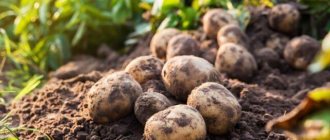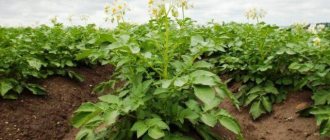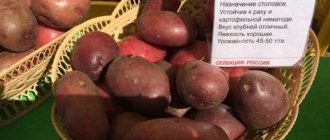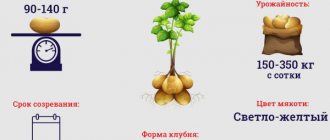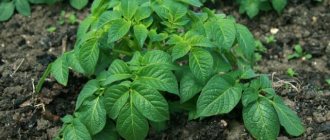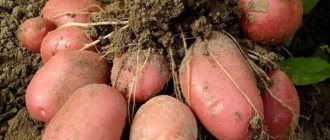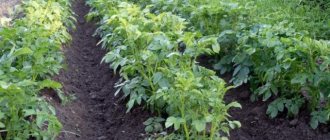Characteristic
Vega is an early ripening table variety. Harvest ripening occurs 60-70 days after planting.
Vega is ideal for industrial cultivation. In addition to high yield (about 250-300 c/ha), the variety boasts good transportability due to its dense shell. Also, the shell protects the tubers from damage during mechanical harvesting (which is constantly practiced in industrial production).
Vega potatoes are unpretentious to growing conditions. It is not afraid of long periods of drought and does not suffer from short-term spring frosts.
The variety has good immunity, protecting it from potato cancer, mosaic and golden nematode. Vega is not protected from late blight, but also does not have a tendency to constantly become ill with this fungus.
As noted above, Vega is famous for its productivity, which can reach 500 c/ha (rarely). On average, the yield does not exceed 300 c/ha. Moreover, each bush produces up to 8-10 large root crops.
Characteristic features of the Vega variety:
- The culture forms medium-sized bushes of an erect type. The height of mature tops does not exceed 50 cm.
- The leaves have a characteristic waviness along the edges. The color of the leaves is intense green. The number of leaves on the shoots is small.
- During the growing season, the bush blooms with large cream flowers. They are collected in a neat corolla.
Characteristics of tubers:
- The tubers are oval with small, shallow, barely noticeable eyes.
- The weight of a ripe root crop is 90-120 g.
- The potato is covered with a medium-thick yellow shell.
- The amount of starch in tubers ranges from 10% to 16%. The percentage of this substance is affected by the quality of the soil. The more nutritious the soil, the more starch, the less nutritious the soil, the less starch.
- The pulp is light lemon color. Does not darken when cooked, fried or damaged.
- Tubers have high shelf life, up to 99%.
The history of the origin of the Vega potato variety
The Vega variety was born thanks to the efforts of German breeders from the Norika company. Their goal was to develop early-ripening potatoes that adapt well to weather conditions and are disease-resistant. After numerous control plantings, the task was realized, potatoes began to spread throughout Western countries, and then reached Russia, Ukraine and Belarus. In our country it was officially recognized and entered into the State Register in 2013.
Advantages and disadvantages of the variety
The variety has a lot of advantages, thanks to which it has gained good popularity in a short time:
- Good taste.
- Lack of deep eyes.
- Large tubers with a “dry”, non-watery structure.
- Simultaneous ripening of root crops.
- High shelf life - 99%.
- Versatility – Vega is suitable for use in any form.
- The variety is resistant to most known fungal diseases.
There are no disadvantages as such. One can only note the sensitivity to irrigation and frequent damage by the Colorado potato beetle. But these shortcomings can be attributed to any potato variety.
Reviews about the variety
Tubers of the "Vega" variety have a pleasant rich taste, without wateriness or excessive dryness. The average starch content makes the tubers versatile: they can be deep-fried, added to soups, side dishes, vegetable chips, stuffed and baked. The tubers are not subject to overcooking and do not lose their shape. Not suitable for making purees. The high carotene content makes it possible to use potatoes in baby and dietary foods. The flesh does not darken when cut and cooked.
We invite you to familiarize yourself with potato varieties that have different ripening periods:
Correct fit
The Vega variety develops best in light, fertile soils. It is good to plant this crop after legumes, cucumbers or herbs.
Only healthy medium-sized tubers (about the size of a chicken egg) are allowed for planting. Also, planting material must be germinated.
The germination procedure looks like this:
- A month before planting the material, the selected tubers are transferred to a lighted room. In this room the air temperature should not fall below +15 degrees Celsius.
- Root vegetables can be placed in boxes or on special racks. It is advisable that the planting material is not arranged in a heap.
- Tubers that have sprouted are hardened by taking them outside once a day for a few minutes.
Planting of Vega potatoes begins in late April to mid-May (depending on the growing region). You need to focus on the ground temperature. It should warm up to at least +8-10 C.
We recommend reading: “Description of the Arizona potato variety”
When the planting material is ready, the planting process is performed. They dig holes no more than 15 cm deep (in warm regions, up to 20 cm in cold regions), at a distance of 30-40 cm from each other. Row spacing is made about 60-70 cm. This distance will not only make it easier to care for the crop, but also protect it from a number of diseases, in particular late blight.
Features of cultivation
The Vega variety prefers light sandy soils . Before planting, the soil is thoroughly loosened and compost or wood ash (preferably birch) is laid out in the holes. Before planting, the tubers are pickled; they can be planted whole or in segments.
When planting, the distance between bushes is 35 cm, row spacing is at least 75 cm. Drip irrigation is recommended to ensure normal soil moisture. Twice during the season, plantings are hilled , weeds are destroyed manually or with the help of herbicides.
Potatoes are little susceptible to mechanical damage; the thin but strong peel reliably protects the tubers when digging . After harvesting, the potatoes need to be dried on the edge or under a canopy, which will ensure good shelf life. During storage, the tubers do not need to be sorted.
The variety is very sensitive to watering . Abundant moisture is necessary during flowering; later the amount of watering can be reduced. During the season, plantings are fertilized 1-2 times with mineral complexes, diluted mullein or bird droppings.
Seed potatoes can be collected independently; they are practically not subject to degeneration. Promising bushes should be marked in advance with bright ribbons. For planting, medium-sized, even potatoes are selected that are not damaged, have not been sick or are not affected by pests.
There are many different ways to grow potatoes. On our website you will find a lot of interesting information about Dutch technologies, cultivation without hilling and weeding, the method under straw, in bags, in barrels, in boxes.
Care
Caring for Vega potatoes is quite simple. It is enough just to follow a number of rules that gardeners have been using for centuries:
- Hill up the potatoes at least twice. When we hill up potatoes, the area is cleared of weeds, the soil is loosened, and the tops become less spreading. Experienced experts note that if hilling is not carried out, the harvest will be 20-30% less.
- Do not apply large amounts of fertilizer. Potatoes are responsive to fertilizing, but only in moderation. For example, this crop does not really like nitrogen-containing fertilizers, since they stimulate the growth of tops, and thereby inhibit the development of tubers. Usually one autumn feeding is enough.
- Water. But water sparingly. Again, it is not recommended to water before the tops grow to 10-15 cm. Also, it is not recommended to water after flowering.
- Periodically inspect the tops for diseases and parasites.
Harvesting and storage
When the potato tops are completely dry, you can begin harvesting. Two weeks before digging up Vega potatoes, it is necessary to mow the tops and remove them from the site. The dug up root crops should be dried in the open air, then transferred under any canopy, and then placed for storage in a dark, dry, well-ventilated area.
Pests and diseases
Like other vegetable crops, potatoes are susceptible to attack by parasites and a number of diseases:
- Colorado beetle. This parasite, both in the adult and larval stages, has an enviable appetite. They can gnaw the leaves of the tops clean, leaving only the stems. Naturally, this affects the harvest. Insects must be removed manually or poisoned with special insecticides.
- Wireworm. This parasite also often attacks Vega tubers. It penetrates deep into the potatoes, which leads to their rotting. To combat this parasite, special insecticides are used.
- Late blight. The main fungus that attacks this crop. The most common cause of late blight is high humidity. They fight the fungus by removing infected parts and treating with fungicides.
Preparing the soil and planting site
You can count on a good harvest only if the land is carefully prepared for the upcoming planting. First of all, you need to choose a soil with the most suitable structure. The soil should be light sandy.
It is imperative to comply with crop rotation requirements. When choosing a plot of land, you need to take into account what crops were grown here in the previous season. As soon as an area suitable for planting potatoes has been selected, you can begin preparing it. Preparatory work begins several months before the upcoming planting, namely in the fall.
At the beginning of September, the site needs to be sown with green manure:
- rye;
- wheat;
- barley.
This must be done at the beginning of the month, without waiting for the onset of its third decade. Before snow falls, the soil is dug up, leaving large clods of soil behind. If you don't break them up, the number of weeds will be significantly reduced. After such clods freeze, the seeds of harmful plants lose their viability.
When winter comes, the vegetable grower can rest. Agricultural work will resume when spring comes. After the snow melts, the area needs to be loosened. Then the preparation of furrows and holes begins. Compost and ash are placed at the bottom.
Simple gardeners who grow potatoes for themselves do it by hand. For industrial scale, a mechanized method is used. The quality of the harvest does not deteriorate from this.
Description of the variety
The Vega potato variety produces a high yield; on average, from seven to nine large-sized potatoes are harvested from one bush. The tuber is medium in size, round-oval in shape, weighs from 85 to 100 g.
Vega is distinguished by its small bush size, the stems are erect, sometimes semi-erect. The leaves are simple in shape with a dark green tint, the edges are slightly wavy. The bush is characterized by an average degree of foliage. The flowers are collected in corollas, are large in size, and are white-cream in color.
Advantages and disadvantages
The characteristics of the Vega variety are distinguished by many quality indicators.
This proves that the Vega potato variety has some advantages over other varietal potato varieties.
Vega seed potatoes have a number of advantages:
- excellent taste;
- high yield (from 230 to 375 centners per hectare);
- the tubers have a thin skin with a few eyes;
- large fruits with a non-watery, dry structure;
- according to average starch content - from 10 to 16%;
- simultaneous ripening of tubers;
- shelf life is about 99%;
- the variety is universal for transportation over long distances;
- resistance to various viral diseases, common scab, cancerous growths on the surface of tubers, as well as tobacco mosaic.
The disadvantages of this vegetable include sensitivity to watering. As with many representatives of nightshade crops, potatoes of this varietal variety are characterized by damage from the Colorado potato beetle.
The Vega potato variety does not require special agrotechnical skills, as it easily tolerates temperature fluctuations and changes in humidity. Experienced vegetable growers recommend pre-germinating the tubers and then warming them up.
- Choose healthy tubers with a smooth surface and no signs of disease.
- Install special shelving structures or containers in a well-lit room where the air temperature is from 15 to 17˚ C.
- Place the potatoes in layers on the prepared area.
- In order for the tubers to germinate evenly, it is necessary to rearrange the boxes from time to time.
The first shoots appear after 21 days. You should also harden the sprouted tubers; for this you need to periodically change the temperature conditions sharply (a decrease of 6-8˚ C). This method promotes the activation of gosta eyes and is a guarantee of simultaneous germination of tubers and a high yield.
Soil preparation
Qualitative indicators of the yield of Vega potatoes are observed when planting sprouted tubers on light sandy soils. For effective fruiting, the soil must be properly prepared.
Features of site preparation:
- Choose a dry place to plant tubers.
- Loosen the soil.
- Pour a small amount of wood ash and compost substrate into each hole.
It is recommended to sow green manure (rye, barley, wheat) in the area where potatoes will be grown in mid-September.
Read also: Zucchini - Gribovsky 37 - (10 photos): description of the white-fruited variety, planting and caring for a bush vegetable, reviews
The soil needs to be properly prepared
Such cereal herbs will help enrich the soil with useful microelements during the process of their own decay. In some cases, it is also possible to use ready-made fertilizer solutions for nightshade crops. In autumn, the soil should not be broken into clods. Large soil fractions will freeze better in winter, and along with them most of the weed seeds will be destroyed.
Planting
The characteristics of Vega potatoes imply mid-early planting of sprouted tubers - late April or early May. At this time, the soil warms up well, which promotes further effective growth of tubers.
- Reject tubers without sprouts or with sluggish thin sprouts, as well as small potatoes weighing less than 30 g.
- Planting depth – 10-12 cm.
- Dig holes in increments of 35 to 38 cm.
- The distance between rows is from 70 to 75 cm.
- Place the tubers in the holes and cover them with fertile soil.
The growing season of this varietal variety ranges from 60 to 69 days. According to reviews from experienced vegetable growers, there is no need to water after planting tubers.
During the entire growing season, it is recommended to hill up the bushes at least twice. It is also necessary to ensure that weeds do not spread; for this you need to regularly weed the plants.
Weed control can be done manually. It is also possible to use herbicides, which are an effective way to kill weeds.
Vega potatoes are very sensitive to watering, so it is recommended to moisten the soil infrequently but generously. To get a high yield, moisture must saturate the soil to 40-45 cm.
The optimal solution to ensure proper watering is the drip irrigation method. Using this method of moistening, moisture will flow directly to the tubers, which will have a positive effect on yield.
Throughout the growing season, potatoes should be fertilized; it is recommended to carry out two feedings. During the first feeding during the development of tops and the formation of tuber groups, ammonium nitrate or a weak urea solution is used.
During the second feeding, potassium sulfate or superphosphate fertilizers are used. Also, after the flowers have appeared and before the initial stage of withering of the tops, mineral fertilizers should be applied. No further fertilization is required.
Pest treatment
This variety needs treatment for pests. When plants are damaged by the Colorado potato beetle, various control methods are used, including mechanical destruction of pests after manual assembly.
Bushes are treated with the following solutions:
- chemicals Sonnet, Regent;
- herbal tinctures of celandine and acacia.
Also, some gardeners dust the bushes. To do this, pour wood ash into a bucket and use a broom to sprinkle all the bushes, even those that do not have Colorado potato beetles. Dusting can be done using a regular sieve.
Tubers can often be damaged by wireworms, so when planting, it is recommended to pour three or four granules of superphosphate fertilizer into the hole, which are pre-sprayed with insecticidal preparations.
As a natural way to prevent nightshade pests, you can sow crops such as alfalfa or mustard. According to reviews from vegetable growers, crop rotation is important; potatoes are planted after root crops. This variety is not recommended for planting after tomatoes, since both types of nightshade crops are attacked by the same pests.

